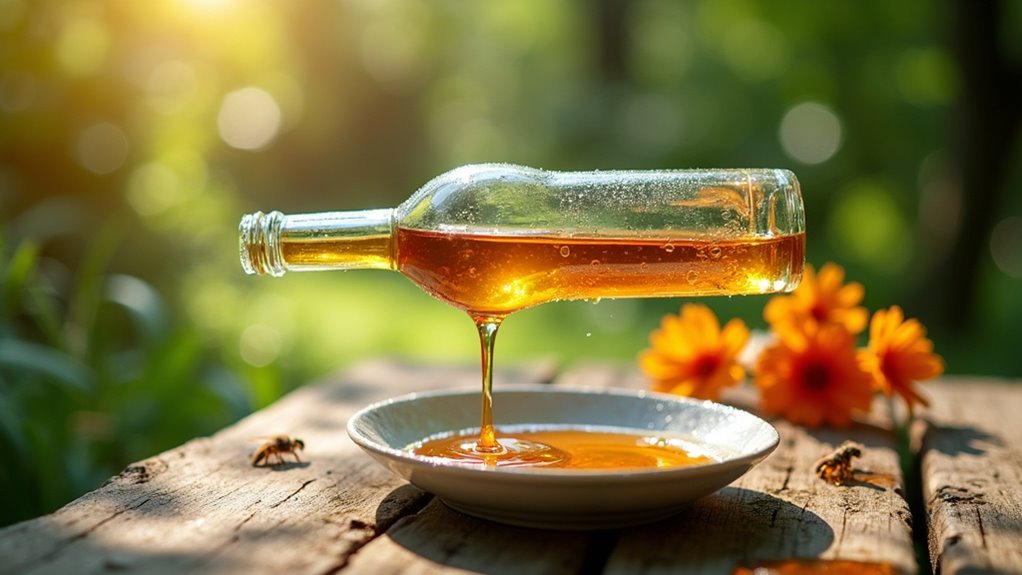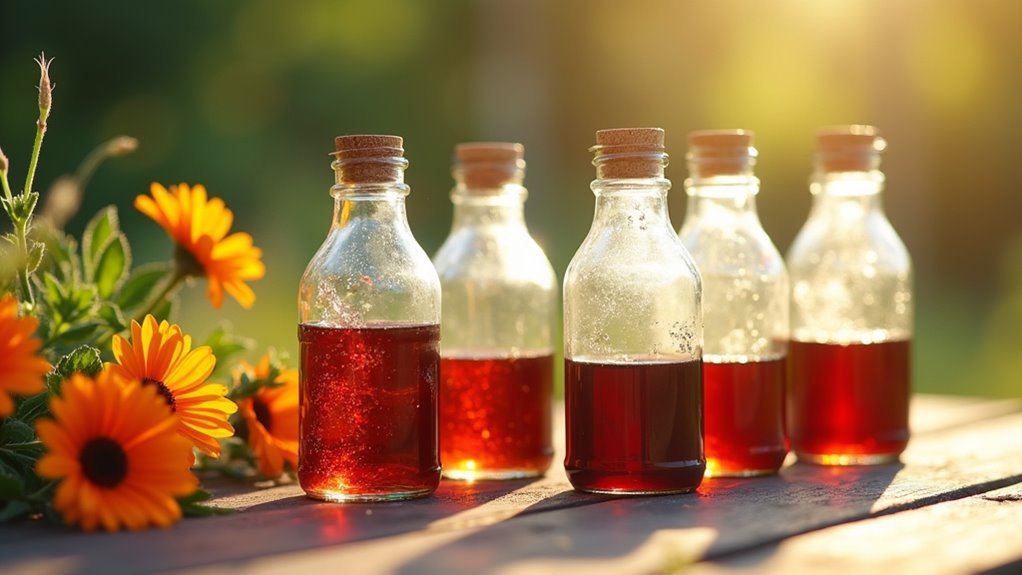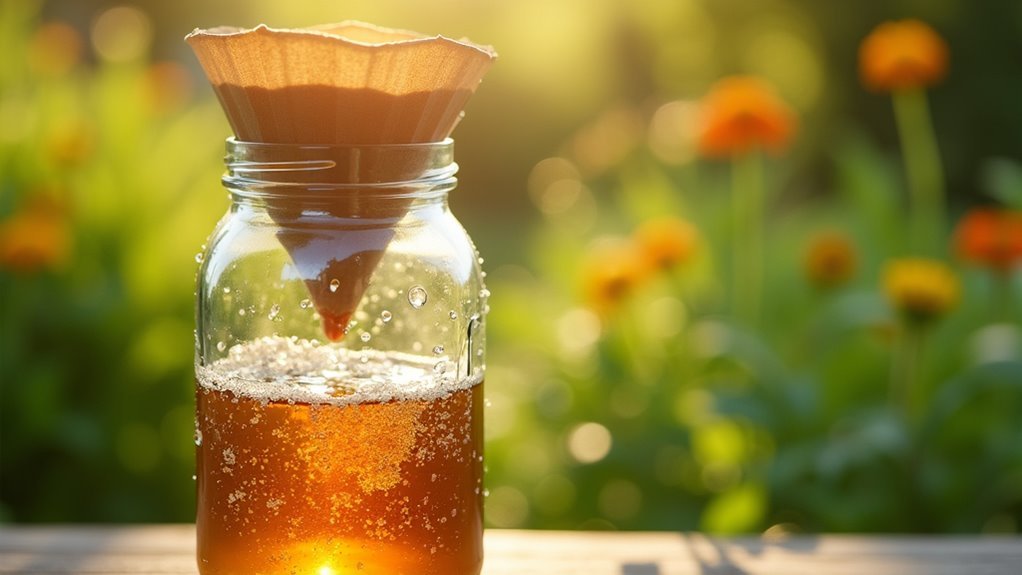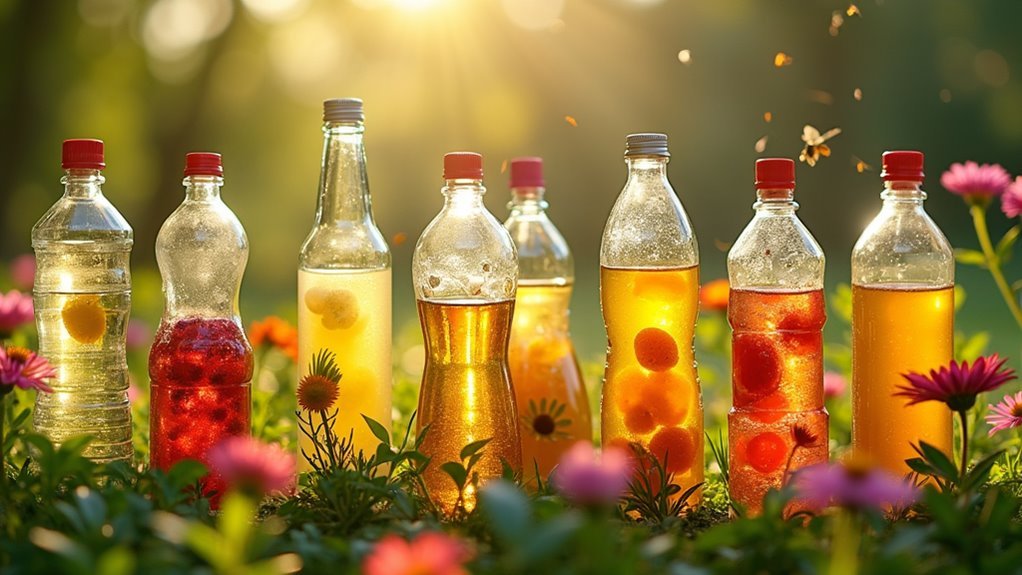You can create effective wasp traps using plastic bottles, glass jars, or buckets with sweet baits like sugar water or fruit juice. Cut bottle tops and invert them to form funnels, or use jam-filled jars covered with punctured foil. For early season, try protein baits like lunch meat, then switch to fruit-based options later. Position traps at least 27 feet from dining areas and add soapy water or olive oil to prevent escapes. These proven methods will transform your outdoor entertaining experience.
Classic Inverted Bottle Trap With Sweet Bait

When summer gatherings are disrupted by aggressive wasps, you can easily create an effective trap using just a plastic soda bottle and sweet bait.
Don’t let wasps ruin your outdoor fun when a simple DIY bottle trap can solve the problem instantly.
This classic inverted bottle trap works by cutting off the bottle’s top and inverting it into the bottom half, creating a funnel entrance. Fill it with 3/4 cup sugar water or fruit juice to attract wasps seeking sweet substances during late summer.
Place the trap at least 27 feet from outdoor dining areas to draw wasps away from guests. Coat the bottle’s interior with olive oil as a slippery substance preventing escape.
Replace the bait weekly to maintain ideal catch rate. These homemade wasp traps effectively protect your entertaining spaces while requiring minimal materials and effort.
Hanging Glass Jar Trap for Garden Areas
For garden areas where wasps frequently invade flower beds and fruit trees, you can construct a hanging glass jar trap that’s both discreet and highly effective.
Start with a clean glass jam jar and fill it with old jam mixed with hot water to create an irresistible wasp bait.
Cover the jar opening with silver foil, securing it with an elastic band, then puncture a small hole allowing wasps entry while preventing escape.
Hang your trap strategically in garden spaces or near outdoor dining areas to draw wasps away from guests.
Regular baiting guarantees continued effectiveness, especially during late summer peak activity.
Always wear gloves when handling the trap, as trapped wasps become aggressive when disturbed.
Protein-Based Bottle Trap for Early Season

You’ll need fresh protein bait like lunch meat or raw hamburger to attract hungry wasps during their early season hunting phase.
Set up your bottle trap in late spring when wasps are actively foraging for protein to feed their developing larvae.
Position the trap away from your outdoor dining areas but close enough to wasp activity zones for maximum effectiveness.
Spring Meat Bait Selection
As spring arrives and wasp colonies begin rebuilding their populations, these insects prioritize protein-rich foods over the sugary substances they’ll crave later in the season.
You’ll find lunch meat and hamburger particularly effective as bait during this time. These protein sources attract hungry wasps seeking nutrients for their developing colony.
For your DIY trap setup, cut meat scraps into small pieces that’ll fit through your plastic bottle’s inverted neck. Add water to create a drowning solution—this prevents wasps from escaping once they enter.
Fresh hamburger works exceptionally well because its strong scent travels far, drawing wasps from considerable distances.
Replace your bait every few days to maintain its appeal, ensuring your trap remains effective throughout spring and into summer when wasp activity peaks.
Early Season Trap Setup
Creating an effective early season wasp trap requires nothing more than a standard plastic bottle and a few simple modifications. Remove the cap and cut the bottle about one-third from the top. Invert this section to create a funnel, then tape it securely. This DIY wasp trap design guarantees wasps can’t escape once inside.
For early spring trapping, trap and fill the bottom with protein-based baits like meat scraps mixed with water. While sweet smell baits work later, protein attracts queens establishing colonies. Add vinegar to enhance effectiveness.
| Setup Step | Distance/Timing |
|---|---|
| Trap placement | 27+ feet from dining |
| Bait replacement | Every 3 days |
| Daily monitoring | Check trapped wasps |
| Safety distance | Hang your wasp trap away from activity |
Handle with protective clothing when checking your trap.
Outdoor Bucket Trap With Soapy Water
One of the most effective wasp traps you can build uses a simple 5-gallon bucket filled with soapy water.
Create your outdoor bucket trap by filling it with 2-3 inches of water mixed with 5 tablespoons of dish soap per gallon.
Suspend protein bait like meat scraps on an 18-inch stick above the soapy water during spring and early summer to attract wasps effectively.
Switch to fruit-based baits in late summer and fall when wasp preferences change.
Cover the bucket with a wide mesh screen to keep animals out while allowing wasp entry.
Position your trap at least 27 feet from gathering areas to prevent stings.
Refill with fresh bait solution and clean every three days for effective capturing throughout the season.
Vinegar and Sugar Funnel Trap

Another highly effective homemade wasp trap uses common household ingredients to create a powerful attractant that won’t harm beneficial bees.
You’ll need 3/4 cup white vinegar, 2 tablespoons sugar, and 1 teaspoon salt to make potent bait. Cut the top off a plastic bottle and invert it inside the bottom section, forming a funnel that allows wasps to enter but prevents escape.
Position your trap outdoors, away from dining areas, to attract wasps from food and gatherings. The vinegar naturally repels bees while drawing in wasps effectively.
Check your trap weekly and replace the bait when it fills up or loses potency. This simple yet powerful method keeps your outdoor spaces wasp-free while protecting beneficial pollinators.
Slippery Barrier Bottle Trap With Handle
This enhanced trap design combines the proven funnel method with a slippery barrier that dramatically improves capture rates.
To make a DIY wasp trap, cut a 2-liter bottle below the neck, creating a funnel you’ll invert into the bottom half. Coat the interior with olive oil or petroleum jelly—this slippery barrier prevents wasps from escaping.
Create a handle by making two holes on opposite sides of the funnel’s edge, then thread 12-inch string through them for easy hanging. Fill your bottle trap with 1-2 inches of sugar water mixed with dish soap to attract wasps while ensuring they drown.
This design is easy to make and perfect for outdoor hanging from branches or tables 4 feet high.
Jam and Hot Water Mason Jar Trap
Mason jars offer an excellent foundation for creating highly effective wasp traps using common household ingredients. Start by adding old jam to your glass jar’s bottom, then mix it with hot water to create irresistible bait for wasps. The sweet mixture attracts these pests during summer months when they’re actively seeking sugary substances.
Cover the jar with silver foil and secure it using an elastic band around the rim. Carefully poke small holes in the foil – large enough for wasps to enter but small enough to prevent escape.
Position your trap near outdoor dining areas where wasp activity is highest.
Always wear gloves when emptying the trap, as handling live wasps poses serious stinging risks that could provoke aggressive behavior.
Frequently Asked Questions
What Is the Most Effective Homemade Wasp Trap?
You’ll find the most effective homemade wasp trap uses a cut plastic bottle with its top inverted, creating a funnel entrance. Add protein bait in spring, sugary substances in summer, plus dish soap to prevent escape.
What Do You Bait Wasps With in the Summer?
You’ll want to use sugary substances like fruit juice, soda, or diluted jam mixed with dish soap. Add vinegar to deter bees while keeping wasps attracted, and change your bait weekly.
What to Put in a Jar to Attract Wasps?
You’ll want to put sugary bait like diluted fruit juice or sugar water mixed with dish soap in your jar. Add vinegar to deter bees while targeting wasps specifically.
What Is the Bait Recipe for a Wasp Trap?
You’ll need 3/4 cup white vinegar, 2 tablespoons sugar, and 1 teaspoon salt for an effective wasp bait. Add a few drops of dish soap to prevent wasps from escaping once trapped.
In Summary
You’ve now got seven effective wasp trap options to keep your summer gatherings peaceful. Don’t wait until wasps become a problem—set up traps early in the season when they’re seeking protein, then switch to sweet baits later. Place them away from dining areas but within your property’s perimeter. With these simple homemade solutions, you’ll reclaim your outdoor space without spending money on expensive commercial traps.





Leave a Reply